Training Manual Menu | Main Menu |
Training Manual Menu | Main Menu |


| • What Collaboration Means. the Framework defined - communicate / cooperate / collaborate - case scenario - the Collaboration Framework overview.
• How Collaborations Fit Within Changing Community
Conditions.
• Planning For Change.
• How Change Comes About.
• Beliefs About Change.
• Using The Framework for Collaborative Efforts.
• Understanding Collaborative Goals.
|
| the Collaboration Framework
bringing individuals, |
3 |
 COOPERATE |
 COMMUNICATE |
| Unit 1 case scenario This is an actual case study of collaboration in which names have been changed. THE COMMUNITY: Larkin County has a population of approximately 20,000 people. Principle industries are agriculture, forest products and tourism. There is a range of socioeconomic levels. THE LEADERSHIP: Community leaders—the County Commissioners, school superintendent, key businesspeople—hold much of the decision-making power within the county. THE PROBLEMS: They were not alarmed when two problem indicators developed: (1) 51% of the high school students had dropped out (1/2 of the dropouts were girls), and (2) Larkin County had the highest rate of teen pregnancy in the State, and it was twice the state average (98% of these girls had at least one child before dropping out). But the perception of key leaders was, "this is the way it has always been, and nothing we can do will change that." AWARENESS & DIVERSITY: Informally, three people began to meet over coffee, talking about how awful these issues were. After a while their discussion shifted from "ain't it awful" to "what do you think we can do?" They began seeking out environments where key leaders met in common, like the Rotary Club, talking with more people, until more concerned citizens—both youth and adults—wanted to investigate the problems. THE OUTCOMES: Two years later they had a group formed to study the issue. Another two years went by and 11 different organizations within their community had a portion of their baseline budget dedicated to teen pregnancy prevention and intervention programming. And in the succeeding years they have seen the percentages of high school dropouts become less, along with a remarkable decrease in the percentage of teen pregnancy within their county. |
Unit 1
the Framework overview

Unit 1
rating community conditions
| Competition | Collaboration |
| Reaction | Prevention |
| Experts | Citizens |
| Activity Driven | Vision Driven |
| Control Decisions | Share Decisions |

B= Desired Results
![]() =Moving From A to B
=Moving From A to B
| Unit 1 focusing map for planned change | |
 |
Training Manual Menu | Main Menu |